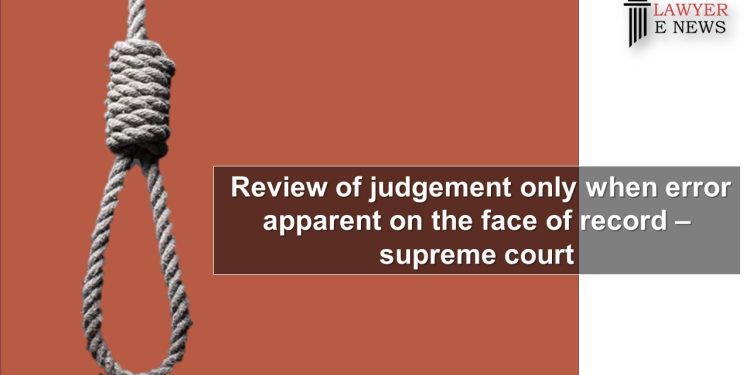Review of Judgement Only When Error Apparent On the Face of Record – Supreme Court

On dated 21 March 2013, Supreme Court in a recent Judgement (Sundar @ Sundarrajan Vs. State by Inspector of Police) held that Article 137 of the Constitution grants the Supreme Court the power to review any judgment pronounced by it, subject to provisions of law made by Parliament or any rules under Article 145. The Supreme Court Rules 2013 provide for the Court to review its own judgment or order, but only on specific grounds mentioned in the Code of Civil Procedure 1908 for civil proceedings and on the ground of an error apparent on the face of the record for criminal proceedings.
Facts
The petitioner is accused of kidnapping and murdering a 7-year-old child and was convicted and sentenced to death by the Sessions Judge and the High Court confirmed both the conviction and the award of the death sentence. The Supreme Court also dismissed the petitioner’s appeal and confirmed the judgment of the High Court, after a detailed appreciation of facts.
Observed and Held
Supreme Court referred case of Mofil Khan v State of Jharkhand and noted that the power of review is not a rehearing of the appeal all over again and that the applicant must show that there has been a miscarriage of justice. An error that requires a process of reasoning to detect is not an error apparent on the face of the record justifying review. The Court will not entertain re-argument of the appeal or a request to consider another view on the conviction or sentence unless there has been a glaring omission or patent mistake due to judicial fallibility, leading to a miscarriage of justice.
Supreme Court noted that victim, a 6-year-old boy, was last seen with the petitioner, who was identified by two witnesses. The petitioner was arrested and made a confessional statement in which he admitted to strangling the victim and throwing his body into a tank. Material objects were recovered on the basis of the petitioner’s statement, including the victim’s school bag, books, and slate. The petitioner was convicted based on the testimony of the witnesses, his confessional statement, and the recovery of the material objects. The evidence in the form of Call Detail Records (CDRs) was used to corroborate the testimony of the witnesses and the recovery of the mobile phone on the basis of the petitioner’s confessional statement. The High Court upheld the conviction, finding that there was sufficient evidence to establish both the kidnapping and murder of the victim by the petitioner.
Supreme Court further noted that judgment of the trial court was based on the general principle of punishing kidnappers with extreme penalty to prevent society from getting spoiled. The High Court affirmed the trial court’s judgment, stating that leniency towards the accused would be a mockery of the criminal system.
The Supreme Court examined the aggravating circumstances of the crime but did not find any mitigating circumstances. It noted that the choice of kidnapping the male child for ransom was well planned and motivated, which had grave repercussions for the parents of the deceased. However, the sex of the child should not be considered as an aggravating circumstance as it involuntarily furthers patriarchal value judgments that courts should avoid.
Supreme Court during hearing received an affidavit from the police stating that the petitioner’s conduct was satisfactory and that he has not been involved in any other case. However, the Superintendent of Prisons submitted a document stating that the petitioner had tried to escape from prison on 6 November 2013, which was not included in the affidavit. The Court considered the mitigating factors in the case, including the petitioner’s age, lack of prior criminal history, and satisfactory conduct in prison, and concluded that although the crime was serious, it was not appropriate to affirm the death sentence.
The court has found the petitioner guilty of kidnapping and murdering a 7-year-old child and sees no reason to interfere with the conviction. However, they note that the sentencing hearing was not conducted separately, and mitigating circumstances were not considered before awarding the death penalty.
The court commutes the death sentence to life imprisonment for a minimum of 20 years without reprieve or remission. Additionally, the court issues a notice to the police station to explain why action should not be taken for filing a misleading affidavit, and the matter is registered as contempt of court.
Sundar @ Sundarrajan Vs. State by Inspector of Police






